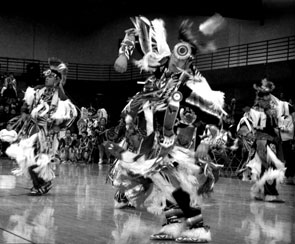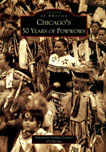|

 |
Chicago's Fifty Years of Powwows |
<Adapted from the book of the same name>
Men's Grass Dance
Of the many stories about the Grass Dance, perhaps the most well known is that Grass Dancer created a dance circle by stomping down the tall prairie grasses. Modern powwows often begin with a single Grass Dancer who ceremonially prepares the dance area for all the other participants. Follow this link to see some Grass Dancers in action. >>>add video clip<<< >>>add historical picture/painting
near bottom of page<<<
A great deal has been written about the Grass or "Omaha" Dance, one of the oldest of the surviving tribal dances. Borrowed from the Omaha tribe, perhaps in the 1860s, the Grass Dance is very popular today. Dancers' outfits are decorated with thick hanks of long, colorful fringe, which sway gracefully with the movement of the dancers' bodies in a movement reminiscent of the long blowing grass of the prairie. Several tribes dance their own version of the dance, and some say that the fringes replace the grasses that the dancers originally would tuck into their belts. Another tribe remembers dancing in order to flatten out the long prairie grasses in preparation for a ceremony. Still others think it originated to celebrate victory over an enemy. Many dancers wear the hair roach, the crow belt, and the eagle bone whistle—original emblems of the Omaha Society.
The basic step of the Omaha dance involves the ball of one foot being tapped on the "one beat" and placed down flatly with the next beat, then repeating the action on the opposite foot without missing a beat. Each time the foot is placed flatly on the ground, the weight shifts to that foot. Dancers are expected to keep their heads moving either up and down with the beat of the Drum, nodding quickly several times to each beat, or moving from side to side. The purpose of this movement is to keep the roach crest feathers spinning. To keep the feathers moving constantly is one sign of a good dancer.
Forward to the next page of this essay Back to the previous page of this essay Back to the menu of powwow dances Back to the menu page for this essay Back to Online Essays
|
| |
Department
of Anthropology |
copyright ©
2002 University of Illinois, All rights reserved. |





